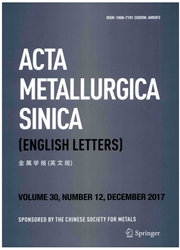

 中文摘要:
中文摘要:
在 multilayered 的变丑坡度合并二不一样的以脸为中心的立方的金属的热结合转动的合成材料,即,黄铜和 Cu,被在 composites 的不同厚度位置描绘变丑微观结构,坚硬和质地调查。为组成的金属,每张金属表的中心部分形成包含粗糙的谷物的基础,当时极其细小的谷物并且重要砍在外部部分的 banding 形式。作为变丑增加,跨接口砍发生在 composites 的 Cu 表。然后,谷物破碎,砍 banding 和动态恢复成为影响金属的坚硬的主要因素。而且在共同使变形的 composites,在黄铜和 Cu 之间的接口在单个金属的质地开发起一个作用。
 英文摘要:
英文摘要:
The deformation gradients in multilayered hot roll-bonded composite materials incorporating two dissimilar face-centered cubic metals, i.e., brass and Cu, were investigated by characterizing the deformation microstructure, hardness and texture at different thickness positions of the composites. For the constitutive metals, the center part of each metal sheet forms the substructure containing coarse grains, while the ultrafine grains and significant shear banding form in the outer part. As deformation increases, the cross-interface shear occurs in the Cu sheet of the composites. Then, grain fragmentation, shear banding and dynamic recovery become the main factors that influence hardness of the metal. Moreover, in the co-deformed composites, the interface between brass and Cu plays a role in texture developments of the individual metals.
 同期刊论文项目
同期刊论文项目
 同项目期刊论文
同项目期刊论文
 The evolution of recrystallized texture of cold-rolled pure copper annealed with a magnetic field in
The evolution of recrystallized texture of cold-rolled pure copper annealed with a magnetic field in Influence of Shear Banding on the Formation of Brass-type Textures in Polycrystalline fcc Metals wit
Influence of Shear Banding on the Formation of Brass-type Textures in Polycrystalline fcc Metals wit 期刊信息
期刊信息
